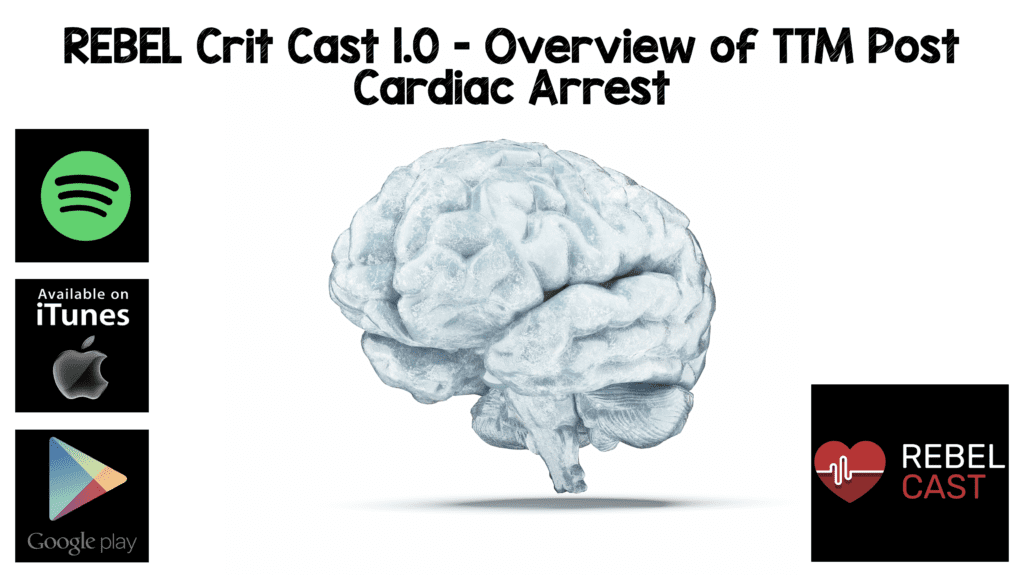
REBEL Crit Cast Episode 1.0 – Overview of Targeted Temperature Management (TTM) Post Cardiac Arrest
Click here for Direct Download of Podcast
Evidence for Cooling in Adults and Children:
HACA Trials (New England Journal of Medicine 2002) [1]
- 275 patients suffering out of hospital arrest with shockable rhythm
- Evaluated 32 – 34°C vs standard normothermia
- Improved survival rate with good neurologic outcome at 6 months (55% vs. 39%)
- Decreased mortality rate at 6 months (41% vs. 55%)
- Used Cerebral Performance Category score (CPC) to classify good neurological outcome
- 1 = Returning back to baseline with mild deficits
- 2 = Moderate disability, able to return to work and living
- 3 = Indicating severe disability
- 4 = Persistent vegetative state
- 5 = Brain dead
Bernard Trial (New England Journal of Medicine 2002) [2]
- 77 patients suffering out of hospital arrest with shockable rhythm
- Evaluated 33°C vs standard normothermia
- Improved survival rate with good neurological outcome at discharge (49% vs 26%)
- Questioned if improved survival rate was secondary to prevention of fever which in turn provided neurological protection
Targeted Temperature Management (TTM) (2013) [3]
- 939 patients, with out-of-hospital cardiac arrest over 36 ICUs
- 80% shockable rhythms, 20% were PEA and asystole
- Evaluated which “dose” (temperature) was more effective, 36°C vs 33°C
- Also used CPC and modified Rankin scores
- Findings suggested NO difference in mortality rate at end of trial (50% vs 48%)
- No difference at 6 months, or survivability with favorable CPC
- Updated ILCOR (International Liaison Committee on Resuscitation) guidelines state that a range of treatment between 32° – 36°C is acceptable
Hyperion Trial (2019) [4]
- 584 patients from 25 different ICUs
- Non-shockable rhythms (i.e. PEA or asystole)
- Compared 90-day mortality and outcome of 33°C vs 37°C
- Rate of survivability with good outcome was statistically significant in 33°C (10.2% vs. 5.7%)
- No difference in mortality rate between target temperatures (85%)
THAPCA [5][6]
- In-Hospital: 257 children aged >48hrs and <18 years of age
- Compared therapeutic hypothermia (33.0°C) vs therapeutic normothermia (36.8°C)
- Primary efficacy outcome: Survival at 12 months after cardiac arrest with a score of 70 or higher on the Vineland Adaptive Behavior Scales, second ed (VABS-II, on which scores range from 20 to 160, with higher scores indicating better function)
- Trial terminated early due to futility
- No difference in primary outcome (Hypothermia = 36% vs Normothermia = 39%)
- Out of hospital: 260 children, aged >48hrs and <18 years (Average age of 1 – 2 years)
- 70% of patients had a respiratory cause of cardiac arrest; ½ had chronic medical conditions
- Compared 33°C (Therapeutic hypothermia) vs. 37°C (Therapeutic normothermia)
- Primary efficacy outcome: survival at 12 months after cardiac arrest with a Vineland Adaptive Behavior Scales, second ed (VABS-II)
- No significant difference in primary outcome between therapeutic hypothermia (20%) vs therapeutic normothermia (12%)
- There was a trend towards improvement of neurological outcome using 33° C, however not statistically significant
Cochrane Neonatal HIE Review 2012 [7]
- Pediatrics with Hypoxic-ischemic encephalopathy (HIE) recommended to cool to 33 – 35°C for infants at 34-36 wks
- 7 trials including 1214 newborns
- Cooling helps to improve survival with good neurological outcome
- Less data for pediatrics, personally recommend 33°C
Brain Injury and Therapeutic Hypothermia:
Mechanism
- Global ischemic injury occurs during cardiac arrest
- Once brain injury sets in, it can be irreversible
- Providers may have one chance at preventing secondary brain injury
- After obtaining ROSC, ischemia reperfusion injury (IRI) takes place
- Post-cardiac arrest, mitochondria switch from aerobic to anaerobic metabolism causing:
- Acidemia
- Increased phosphate and lactate production
- Influx of calcium ions
- Apoptosis
- Glutamate release, which increases the risk of seizures 5-20%
How Does Therapeutic Hypothermia Work?
- A few of the major neuroprotective mechanisms of hypothermia include:
- Decrease in cerebral metabolic rate
- Decrease in acidemia and calcium influx
- Decrease in glutamate release, which may decreases risk of seizures
- Decrease in cerebral edema
- Decrease in free radical production which causes cellular injury and death
- Decrease in cytokine release which can lead to fever even days after arrest
Adverse Effects of Targeted Temperature Management (33°C)?
There is NO difference in major adverse events between cooling to 33°C vs 36 or 37°C. This is just a myth!
Increased Risk of Coagulopathy
- Some patients may come in with major life threatening bleeding already, ( intracranial or GI)
- ILCOR guidelines offers dosing range of 32 – 36°C; target 36° for these patients to decrease risk of further bleeding
Arrhythmia
- Can cause bradycardia
- Monitor blood pressure and perfusion
- Possible use of low dose vasopressors
- If too unstable, increase temperature until satisfactory
Increased Insulin Resistance
- Typically treated with insulin infusion: goal 140-180 mmol/L
- Can also use high dose insulin as acceptable
- If continued hyperglycemia, despite high dose insulin infusion, then increase temperature
- Tight glucose control can lead to hypoglycemia, which can also lead to poor neurologic outcomes
Electrolyte Abnormalities
- Cold-induced diuresis caused by vasoconstriction, leading to increased urine output
- Hypokalemia, hypomagnesemia, hypophosphatemia, hypocalcemia
- Hypokalemia is main concern because it can cause dysrhythmias
- Monitor potassium closely as patients can become hyperkalemic during rewarming
- Tip: Keep potassium low normal prior to rewarming to avoid hyperkalemia
Drug Metabolism
- Hypothermia can affect the liver and its ability to metabolize certain drugs
- Possible prolonged effects of analgesics and sedation medeications
Infection Risk
- Ventilator associated pneumonia
- Can decrease leukocyte function
- Literature does not report this or sepsis as increased risk
Musculoskeletal
- Shivering increases oxygen demand and consumption
- Treat aggressively with sedation or paralytic
- Sedation preferred over paralysis as goal is to decrease oxygen consumption
Therapeutic Hypothermia from Beginning to End:
- Expedite cooling to 33° C within the first 4 hours (podcast I stated 6 hours, but faster the better)
- Keep at targeted temperature for 12-24 hours (ICECAP Trial enrolling patients soon to determine duration of cooling)
- Use of intravascular cooling device (closed-loop feedback) offers tightest control
- Slowly rewarm by 72 hours, be mindful of this stage as patients can still spike fevers
- Target normothermia for a few days after rewarming
References:
- Hypothermia After Cardiac Arrest Study Group. Mild Therapeutic Hypothermia to Improve the Neurologic Outcome After Cardiac Arrest. NEJM 2002. PMID: 11856793
- Bernard SA et al. Treatment of Comatose Survivors of Out-of-Hospital Cardiac Arrest with Induced Hypothermia. NEJM 2002. PMID: 11856794
- Nielsen N et al. Targeted Temperature Management at 33°C Versus 36°C After Cardiac Arrest. NEJM 2013. PMID: 24237006
- Lascarrou JB et al. Targeted Temperature Management for Cardiac Arrest with Nonshockable Rhythm. NEJM 2019. PMID: 31577396
- Moler FW et al. Therapeutic Hypothermia After In-Hospital Cardiac Arrest in Children. NEJM 2017. PMID: 28118559
- Moler FW et al. Therapeutic Hypothermia After Out-of-Hospital Cardiac Arrest in Children. NEJM 2015. PMID: 25913022
- Tagin MA et al. Hypothermia for Neonatal Hypoxic Ischemic Encephalopathy: An Updated Systematic Review and Meta-Analysis. Arch Pediatr Adolesc Med 2012. PMID: 22312166
References:
- Hypothermia After Cardiac Arrest Study Group. Mild Therapeutic Hypothermia to Improve the Neurologic Outcome After Cardiac Arrest. NEJM 2002. PMID: 11856793
- Bernard SA et al. Treatment of Comatose Survivors of Out-of-Hospital Cardiac Arrest with Induced Hypothermia. NEJM 2002. PMID: 11856794
- Nielsen N et al. Targeted Temperature Management at 33°C Versus 36°C After Cardiac Arrest. NEJM 2013. PMID: 24237006
- Lascarrou JB et al. Targeted Temperature Management for Cardiac Arrest with Nonshockable Rhythm. NEJM 2019. PMID: 31577396
- Moler FW et al. Therapeutic Hypothermia After In-Hospital Cardiac Arrest in Children. NEJM 2017. PMID: 28118559
- Moler FW et al. Therapeutic Hypothermia After Out-of-Hospital Cardiac Arrest in Children. NEJM 2015. PMID: 25913022
- Tagin MA et al. Hypothermia for Neonatal Hypoxic Ischemic Encephalopathy: An Updated Systematic Review and Meta-Analysis. Arch Pediatr Adolesc Med 2012. PMID: 22312166
Post Transcribed By: Corinthia Stephanas Gonzales
Post Peer Reviewed By: Salim R. Rezaie, MD (Twitter: @srrezaie)



